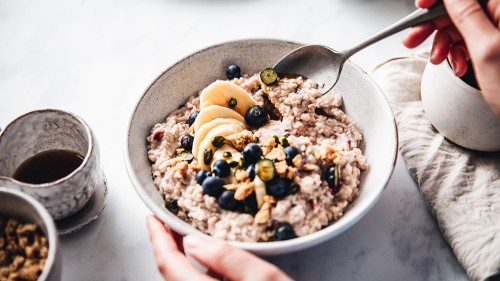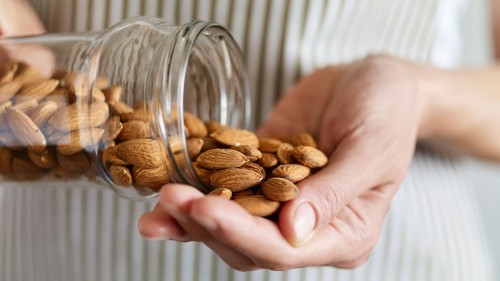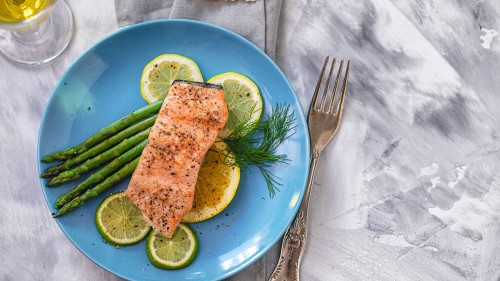How to Lose Weight: A Dietitian Offers 9 Practical Steps
Published on December 19, 2021
Medically Reviewed by Ana Reisdorf, MS, RD
The process of losing weight can often feel overwhelming. We’ll walk you through a simple and practical step-by-step process that covers everything you need to know and will help you lose weight and not gain it back.


Sustained weight loss is a goal for many of us. It’s only natural to want to seek out the quickest way to lose weight, but steady, gradual weight loss is what will help you keep it off.
And when it comes to successful weight loss, it’s not just a matter of “eat less, move more.”
I can’t even tell you how many times I had a client have their doctor say these exact words to them and then send them off to just figure it out.
This often leads them down the path of restrictive fad diets that don’t result in permanent weight loss.
If you want a weight loss plan that is both healthy and effective, we got you covered.
In this comprehensive weight-loss guide, we’ll walk you through a simple step-by-step process to lose weight healthily and not gain it back.
We’ve also included specifics on what to eat, how to exercise, and a sample meal plan for weight loss to get you started.
Step 1: Determine Your Why
The first step in your weight loss journey is to determine your why.
This essential step should not be skipped over because it is your reason and motivation for everything you do throughout this process.
Your “why” is your own personal motivator for taking action to lose weight, and it’s what drives you to continue healthy habits even when you may not want to.
Here are a few examples of a “why:”
- You want to be able to play with your kids without getting out of breath
- You want to feel confident in your clothes and start socializing more
- You have heart disease or diabetes in your family and you want to reduce your risk
- You have constant knee or hip pain and want to live symptom-free
You may determine that you have more than one why, and that’s great! If you have more than one personal reason to lose weight, it will likely only push you more.
Write down your why(s) and keep them somewhere front and center, so you can pull them up when you need motivation.
For example, you can put a sticky note or poster reminder on your refrigerator, so you’ll see it when you’re tempted to overeat.
Or, you can put another reminder near your exercise equipment to motivate you on the days you’re feeling tired.
Either way, seeing those constant reminders will keep you going on the tough days.
Step 2: Start Tracking Your Habits
When working with my weight-loss clients, one of the first things I have them do is start tracking their diet and exercise habits.
Tracking your habits helps you determine a baseline of what you’re doing on a typical basis so that you know where you’re at, what’s working, and what’s not.
Through tracking, you will gain a better understanding of where your challenges lie to know what you need to change.
You can track in one of two ways:
Hand Journaling
If you prefer not to use technology and want to keep it simple, you can track your habits in a paper journal.
Write down everything you’re eating, including meals, snacks, and beverages. Make a note of the time you ate, how much, and how you felt afterward, physically and mentally.
Write everything down without judgment, and try not to change your usual routine at all.
Additionally, write down your exercise routine and how many calories you burned. Make sure to include the length of the exercise, what time of the day it was, and what you did.
Smartphone App
If you want the convenience of tracking on your phone, you can do so using an app like MyFitnessPal or Ate. Both of these apps allow you to track your diet and exercise easily, but in slightly different ways.
- MyFitnessPal: MyFitnessPal is a calorie-counting app, where it tallies up the total calories, protein, fat, and carbs you eat throughout the day. It can also automatically sync with your fitness tracker, so any exercise you do will be added to the app.
- Ate: Ate is a mindful eating visual app. It does not track calories but instead tracks your food and mood relationship. This app can be incredibly helpful in enabling you to become a more mindful eater. Mindful eating can help promote a healthy weight and a positive food relationship. (1)
Be sure to track daily, including weekend days.
Your diet and exercise habits on the weekends may vary significantly from during the week, and so leaving the weekend out may leave out important information for you to know.
Do this daily for at least two weeks to give yourself enough time to see the trends in your habits.
Step 3: Evaluate Your Habits and Emotions
After you’ve determined your diet and exercise habits, now it’s time to evaluate them with a critical lens.
Here are some examples of things to ask yourself after tracking for two weeks:
- Were there times you ate when you weren’t physically hungry?
- Did you overeat at certain times?
- Did you crave certain foods when you were feeling stressed?
- Did you skip any meals?
- How often did you exercise? Did you stick to your plan, or did you back out on certain days? If so, why do you think that is?
These are just a few examples and are not meant to be an all-inclusive list. Jot down anything you noticed in yourself to determine your biggest challenges.
This process can be very eye-opening!
Step 4: Address Any Emotions Head-On
The process of eating is an emotional experience and is rarely all physical.
Through tracking, you may notice that you eat a certain way because of emotions. If this is happening, you’re not alone!
Emotional eating can be a barrier to weight loss because you’re eating when you’re not truly hungry. This typically involves consuming more than your body actually needs.
When you eat when you’re not truly hungry, it can be difficult to know when to stop. This often results in excessive calorie intake, increasing your chances of weight gain.
Addressing the uncomfortable emotion head-on, rather than suppressing it with food, is what will truly fix the problem. To do this, healthier coping mechanisms need to be put in place.
Examples of emotions that may affect eating habits include stress, anxiety, depression, sadness, loneliness, excitedness, or as a reward after a long day.
It’s important to tackle the emotional piece first before trying to change everything in your diet, because emotions are often the underlying cause of our weight struggles.
If this root problem is not addressed first, then chances are these emotions will keep coming back and sabotage your weight loss program.
Here are a few examples of healthier, non-food coping mechanisms for emotional eating:
- Journaling your thoughts
- Taking three deep breaths
- Calling a friend/family member and venting
- Going for a walk
- Playing with your pet
- Painting or doing something with your hands
- Talking with a therapist
Pick at least 2–3 healthy coping mechanisms and write them down. Refer to them any time you’re feeling stressed in the moment and are tempted to eat for comfort.
Step 5: Set Your Goals
Once you have a better understanding of your emotions and habits, it’s time to set specific goals on how to lose weight.
You should set an overall goal for the long-term, such as a certain amount of weight loss, but it’s even more important to set short-term goals.
These short-term goals help you to measure your progress and allow you to take things one step at a time. This often makes the weight loss process feel less overwhelming, as you can celebrate your successes along the way.
Your goals should be SMART goals, which is an acronym used to ensure goals set are more specific and measurable.
S – Specific
Your goals should be specific, not vague.
For example, instead of saying you want to “feel better,” you can say something more specific like “I want to have less knee pain and be able to walk for 20 minutes without stopping.”
Think about what the goal specifically means to you, and set it with intention.
M – Measurable
Your goal needs to be something you can measure to track your progress.
For example, instead of saying, “I want to lose weight,” say, “I want to lose 10 lbs.” This is something that you can track to determine if you met your goal or not.
And remember, if you don’t meet this goal right away, it’s okay! It’s important to re-evaluate at this time to see what may have happened.
A – Achievable
Your goal(s) need to be realistic and achievable based on your schedule and lifestyle. If it is too daunting, you likely will not be able to stick to it for long.
R – Relevant
Make your goal relevant to you and your “why.” It has to relate to your own life, or it won’t feel meaningful to you.
T – Time-Bound
There should be a time frame associated with your goal, which will help push you to work towards it.
If you give yourself an infinite amount of time to reach your goal, you likely will procrastinate in taking action.
For example, you want to be able to fit comfortably in your old jeans in 90 days.
Step 6: Create a Calorie Deficit
In order to lose weight, you need to be in a calorie deficit. Being in a calorie deficit means you are taking in fewer calories than you are burning.
Even if you are eating healthy but are eating more calories than your body needs, the scale likely won’t budge.
To determine your calorie goals for weight loss, you can start by using a calorie tracker such as MyFitnessPal.
You simply enter in your height, weight, goals, and activity level, and your calories and macros are calculated for you.
Your “macros” are your macronutrients, nutrients needed in large amounts in the diet – carbs, protein, and fat.
A registered dietitian can also create a personalized weight-loss diet for you and calculate your calorie needs.
Calorie needs for weight loss can range from 1,200 to over 2,000 per day depending on the person. Your calorie goals for weight loss are intended to put you in that calorie deficit.
It’s important to note that, as you lose weight, your daily calorie needs decrease over time. Therefore, you may need to adjust your calorie goals down at some point in order to continue to lose weight. (2)
You may be wondering how you actually create a calorie deficit to start losing weight? (3)
You can do this by either decreasing your calories through your diet, burning more calories through exercise, or a combination of both.
Step 7: Improve Your Nutrition
The easiest way to lose weight is to focus on what to eat more of, instead of what to restrict or avoid. Many weight-loss diet plans are restrictive, and in the long run, they are not sustainable.
While everyone’s nutrition needs are a bit different, here are some general guidelines on what to eat to lose weight.
Fruit
Does this one surprise you? Many people fear fruit nowadays because many diets bash it for its carb content.
The truth is that fruit is definitely not the enemy. Fruit is naturally a low-calorie food that is packed with energizing nutrients and fiber.
Fiber helps to keep you full, and an increased intake of fiber-containing foods like fruit has been linked to increased weight loss. (4)
Enjoy 2–3 of your favorite fruits per day. None are off-limits.
Vegetables
Vegetables are a high volume and easy weight-loss food. High volume basically means you can eat a good amount of it and still lose weight.
Several studies have shown that eating more high-volume veggies can increase weight loss. (5)
Fill half your plate with plenty of non-starchy colorful vegetables such as leafy greens, broccoli, cauliflower, or asparagus. There is really no limit to how many of these veggies you can consume.
Starchy or higher-carb vegetables such as potatoes, beets, squash, and corn should be eaten in moderation.
Lean Protein
Protein is an essential nutrient for healthy weight loss.
High protein foods increase satiety, prevent cravings between meals, and support a healthy metabolism.
Your body has to work harder to break down protein in the body compared to the other two macronutrients — carbs and fats.
Because of this, you tend to torch the most calories from eating protein, which is called diet-induced thermogenesis. (6)
However, even though protein is necessary for weight loss, that doesn’t mean you have to overdo it.
Individual protein needs vary, but on average, about 20–30% of your total calories should come from lean proteins.
Include a lean protein source in each meal such as:
- Boneless, skinless chicken breast
- Fish like salmon, tuna, cod
- Shrimp
- Pork tenderloin
- Ground chicken, turkey, or at least 95% lean ground beef
- Eggs
- Beans and lentils
- Nuts and seeds
- Dairy like Greek yogurt, milk, cheese
Whole Grains
Whole grains, such as whole-wheat bread, oats, quinoa, brown rice, or farro, are nutritious carbs that support weight loss.
Grains are often another supposed “enemy” due to their high-carb and gluten content, but they are not the problem.
In fact, research proves whole grains to be beneficial for weight loss. Observational studies have shown those with higher intakes of whole grains were at a lower risk for weight gain. (7)
Whole grains are more nutritious than their processed and refined grain counterparts like white bread and packaged oatmeal.
The latest U.S. Dietary Guidelines suggest consuming at least 3–5 servings of whole grains per day, where each serving is one slice of bread. (8)
Healthy Fats
While fat contains more calories per serving than fat and carbs, you still need some fat in your diet.
Fat is very satisfying and can help keep you full. This is important when it comes to weight loss, so you don’t want to skimp on it too much.
As a matter of fact, the right types of fats can actually help you burn fat and lose weight! (9)
When choosing your fat sources, you want to eat more of the monounsaturated and polyunsaturated fats, as these are anti-inflammatory and protect your heart.
Some examples include:
- Fatty fish like salmon, tuna, and sardines
- Nuts
- Seeds
- Avocados
- Olives
- Cooking oils such as olive and canola oil
Include one healthy fat with each meal to lose weight and feel satisfied.
1-Day Sample Meal Plan for Weight Loss
To help put it all together, here is a 1-day sample diet plan for weight loss.
- Breakfast: 1/2 cup steel-cut oatmeal with fruit
- AM Snack: Handful of carrot sticks and 1 cheese stick
- Lunch: Salad mix with 4 oz chicken breast and 1/4 cup sweet potato
- PM Snack: Apple with 1 tbsp peanut butter
- Dinner: 4 oz Salmon, 1 cup steamed broccoli, 1/2 cup brown rice
Step 8: Exercise
While weight loss is 80% diet and 20% exercise, exercise is equally as important.
Beyond the many health benefits exercise can bring, it can help you lose weight faster than changing your diet alone.
If you’re not currently exercising, it’s important to start slow and not just jump right into it without a plan. Your body needs to adjust to exercise, and if you do too much too fast, you will likely burn out.
Many of my clients have struggled with an all-or-nothing mentality with exercise and feel it has to be done every day or not at all. This simply isn’t true because the consistency of doing something wins the race.
And don’t just do cardio — strength training is equally as important. While cardio does burn more calories during the workout, strength training has huge perks too.
Cardio
Cardio is great for cardiovascular health and effectively burns body fat and calories. It is also a wonderful stress-relieving, mood-boosting activity.
According to the latest Physical Activity Guidelines for Americans, adults should be getting at least 150 minutes of vigorous-intensity, or 300 minutes of moderate-intensity, exercise every week to cut weight. (10)
Examples of vigorous intensity include running, tennis, cycling, or swimming. Moderate-intensity exercises include walking, dancing, or hiking.
Strength Training
Aside from cardio, strength training also has its benefits. It doesn’t burn as many calories per session as cardio but is a rather slow, steady burn that continues several hours later.
Over time, strength training raises your basal metabolic rate, which is the number of calories you burn at rest. (11)
This is a good thing for your metabolism and for weight loss, and you burn more calories while doing absolutely nothing!
Strength training also builds muscle, making you appear more toned, lean, and strong.
The latest Physical Activity guidelines recommend a minimum of at least two strength-training sessions per week. (10)
Lastly, as you get into a routine with any type of exercise, your body starts to adjust to what you’re doing.
To continue to see results, kick things up a notch every 2–3 weeks by either increasing the duration, intensity, or resistance of your workouts.
And remember, you shouldn’t stop exercising once you reach your goal. Continuing to stay consistent will help keep your weight loss off permanently.
Step 9: Get Ongoing Support and Accountability
Last but certainly not least, having support and accountability is paramount in your weight-loss journey.
Many people are not accountable to themselves but are more inclined to stay the course when they know others are watching.
Enlist the support of a close friend, family member, or health professional to stay on track.
When you share your goals with someone, you make those goals a reality. Ask them to hold you to it and check in with you often.
A health professional such as a registered dietitian can provide ongoing support and accountability so that you don’t forget your “why” when life gets tough.
Continue to have support long-term even after you reach your weight-loss goal. This will help remind you to continue practicing the same habits that brought you so much success.
Frequently Asked Questions
What is the best way to lose weight?
The best way to lose weight is by eating fruits, vegetables, lean proteins, whole grains, and healthy fats.
Staying in a calorie deficit is essential, as well as doing both cardio and strength-training exercises.
What is the fastest way to lose weight?
The fastest way to lose weight is by eating minimally processed foods, exercising regularly, and practicing consistent healthy habits.
There is no magic bullet to weight loss, however, and slow and steady often wins the race in this case.
What is the best diet plan to lose weight?
The best diet plan is well-balanced and includes low-calorie, filling foods such as fruits, vegetables, and whole grains.
Lean proteins and healthy fats, like avocado, are also important.
Is diet or exercise more important to reduce weight?
Diet is a bigger component of weight loss, 80% versus 20% for exercise. Both are very important, but you can’t outrun a poor diet.
What is a healthy rate of weight loss?
According to the CDC, a healthy rate of weight loss is about 1–2 pounds per week. At this rate, it is likely not restrictive and you may be more likely to keep it off. (12)
What if my weight loss slows down or stops completely?
This can be a normal part of the weight-loss process. When this happens, it’s helpful to take a step back and re-evaluate your habits. Has anything changed?
If not, it may be time to either decrease your calories further or increase your physical activity.
Seek the help of a registered dietitian if you need extra help figuring it out.
The Bottom Line
To reduce the overwhelm of weight loss, take things one step at a time. It’s important to remember that nobody feels motivated all the time.
Just keep going even when you don’t want to. Keep practicing until it becomes a routine and an automatic habit. It may not feel like it now, but it will truly become a habit the more you do it!
Seek the help of a friend, accountability buddy, a group program, or a registered dietitian who can support you along your journey.
You can do this!
At WellnessVerge, we only use reputable sources, including peer-reviewed medical journals and well-respected academic institutions.
- Mindfulness Approaches and Weight Loss, Weight Maintenance, and Weight Regain:
https://link.springer.com/article/10.1007/s13679-018-0299-6 - Maintenance of lost weight and long-term management of obesity:
https://www.ncbi.nlm.nih.gov/pmc/articles/PMC5764193/ - Position of the Academy of Nutrition and Dietetics: Interventions for the Treatment of Overweight and Obesity in Adults:
https://www.jandonline.org/article/S2212-2672(15)01636-6/pdf - Fiber Intake Predicts Weight Loss and Dietary Adherence in Adults Consuming Calorie-Restricted Diets: The POUNDS Lost (Preventing Overweight Using Novel Dietary Strategies) Study:
https://pubmed.ncbi.nlm.nih.gov/31174214/ - The Relationship between Vegetable Intake and Weight Outcomes: A Systematic Review of Cohort Studies:
https://www.ncbi.nlm.nih.gov/pmc/articles/PMC6266069/ - Diet induced thermogenesis:
https://www.ncbi.nlm.nih.gov/pmc/articles/PMC524030/ - The Relationship between Whole Grain Intake and Body Weight: Results of Meta-Analyses of Observational Studies and Randomized Controlled Trials:
https://www.ncbi.nlm.nih.gov/pmc/articles/PMC6627338/ - Dietary Guidelines for Americans 2020-2025:
https://www.dietaryguidelines.gov/sites/default/files/2020-12/Dietary_Guidelines_for_Americans_2020-2025.pdf - Metabolic Effects of Monounsaturated Fatty Acid-Enriched Diets Compared With Carbohydrate or Polyunsaturated Fatty Acid-Enriched Diets in Patients With Type 2 Diabetes: A Systematic Review and Meta-analysis of Randomized Controlled Trials:
https://pubmed.ncbi.nlm.nih.gov/27457635/ - The Physical Activity Guidelines for Americans:
https://jamanetwork.com/journals/jama/article-abstract/2712935 - Six Weeks of Moderate Functional Resistance Training Increases Basal Metabolic Rate in Sedentary Adult Women:
https://digitalcommons.wku.edu/cgi/viewcontent.cgi?article=2051&context=ijes - CDC: Losing Weight:
https://www.cdc.gov/healthyweight/losing_weight/






